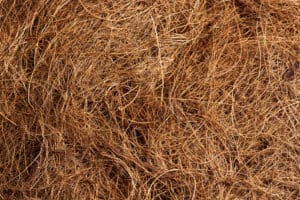Have you heard about coco coir or coconut coir? Coco coir is growing in popularity as a versatile planting material. It’s a renewable material that’s good for our environment since it’s made from the husks of coconut shells. You can find it in our garden center. Just ask any of our staff members for recommendations to help make your landscape and garden beautiful and healthy. We’re confident you’ll be excited about all the uses for coco coir to help your plants develop, grow, and thrive.
 Five Uses for Coco Coir
Five Uses for Coco Coir
- Use it as a liner for your wire-hanging baskets. People use many substances like sphagnum moss, burlap, plastic, and pressed paperboard to provide a foundation for soil and plants within hanging baskets. Instead, try using coco coir. It’s a natural material that maintains a clean appearance and helps keep moisture inside wire-hanging or window boxes. Coconut coir keeps plants healthy, too, because it aids in the transference of oxygen to the roots.
- Create a mini hydroponic farm. Hydroponic farming relies on water to provide sustenance to the plants. Coir decomposes extremely slowly and retains moisture well to provide hydroponics with a healthy, anti-fungal environment. it’s also pH neutral, so no adjustments need to be made for it. Using coconut coir also helps the plant’s roots access valuable nutrients in the water. To use coconut coir in a hydroponic system, soak the coir according to package directions and rinse it well to remove any salt that may exist from commercial processing. The water should rinse out clearly before you use it for planting. Use a 50/50 mix of coir and clay stones to support your plants.
- Get your plants started off right. Have you used those small, brown disks inside tiny pots to start your vegetables and flowers from seeds? Those are likely made from coconut coir. When you soak the disks, they expand and create a lightweight environment to keep seeds moist and provide a good setting to establish a root structure. Once plants are started, they need to be acclimated to the outdoor environment, transitioned to planting soil, and provided additional nutrients.
- Add coconut coir to potted plants. These fibers work well in the bottom of container pots or around the surface as a topper. Gardeners use the material in the bottom of containers to help retain moisture for the roots. When you place it on the top, the fibers will help prevent evaporation. Just a few inches under the soil or around the top will keep potted plants happy, healthy, and bountiful.
- Mixed with soil in planting beds. Coconut coir makes a good mulch in planting beds to keep the soil loose and moist. Rehydrate the coir before adding it to the soil, and then work it into the ground. Add a layer to the top of the soil to keep water from evaporating from the soil.
An important note about coconut coir.
Coconut coir is a fibrous material that will hold in water and slowly release it to the soil around it. However, coconut coir does not have any nutrients by itself–it is only a carrier of nutrients from the water or soil around it. It must be used in conjunction with soil or in hydroponic applications, and you should apply other fertilizers to give your plants the nutrients they need.
Choose Hilton Landscape Supply for all your landscaping needs.
Hilton Landscape Supply can help you with everything you need to transform your yard and garden into a bountiful paradise! Whether your garden needs a fresh load of soil, a new layer of mulch, or the best fertilizers and nutrients for your area, Hilton Landscape Supply is the place to go. We’ve been serving Southern Oregon and Northern California since 1956, so we know what works best for growing healthy plants and vegetation in our regions. Stop by our retail store in Central Point or contact us for more information about all the products we carry to enhance your garden and outdoor living areas.

 Five Uses for Coco Coir
Five Uses for Coco Coir